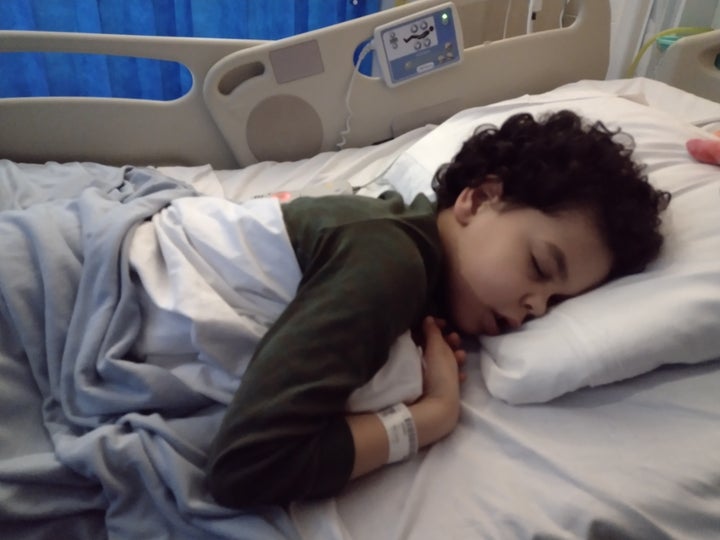
A mum has revealed how she had to quit her job as a teacher because her son’s asthma symptoms, triggered by hay fever, became so bad.
Rebecca Grandison, 43, from Cheshire, says her eight-year-old son Wilf has been hospitalised 15 times since 2019.
“Wilf has always suffered from terrible hay fever, but four years ago he became incredibly unwell,” she recalls.
“He started vomiting, became drowsy, and was struggling to breathe and so I called an ambulance.”
At hospital, doctors initially thought he was suffering from sepsis, but a paediatrician suggested he was put on a nebuliser.
“I was told then that Wilf was in respiratory distress, and although he was officially too young for an asthma diagnosis, he was having a severe asthma attack,” Grandison recalls.
“I was stunned as Wilf didn’t wheeze, and wasn’t even coughing, but as I’ve since learned: not every child will experience symptoms in the same way which is why it’s crucial to know the signs that your child needs urgent help.”
New analysis from Asthma + Lung UK reveals the number of children ending up in hospital with asthma has surged in the past 12 months.
NHS figures reveal that hospital asthma admissions for children increased by 149% in England and Wales between 2021 and 2022.
A total of 19,506 children were admitted with asthma symptoms compared to 7,850 between 2020 and 2021.
The charity suggests the rise could be fuelled by increased mixing after the relaxation of Covid-19 lockdown restrictions, resulting in more exposure to colds and flu viruses, which are common triggers for asthma attacks.
Disruptions due to the pandemic may too have meant that children missed vital routine checks of their medication and care.
The charity is urging parents to manage their child’s asthma proactively and to know what to do in an emergency.
Grandison recalls how the trigger for Wilf’s first asthma attack was tree pollen – he has since been diagnosed with severe asthma and is vulnerable to viral infections, too.

“In the last few years his hay fever and asthma have become so bad that I’ve had to give up work as his symptoms are so unpredictable, and when pollen levels are high, it can be too dangerous for him to leave the house,” she says.
“I never take any chances with Wilf’s asthma as I am all too aware that complacency can kill, and that his symptoms can get worse very quickly.”
The mum says they don’t go anywhere without his inhalers and asthma action plan. She’s also aware of the signs Wilf is starting to deteriorate – he gets very tired, struggles to sleep and doesn’t want to play football.
“He is now under a hospital consultant, but when he was in primary care, I would push for regular reviews and follow-ups after hospital admissions, and I’d take him to the doctor at the first sign of things worsening, and I’ve been told repeatedly by medics that this is always the right thing to do,” says the mum.
“As a parent of a child with asthma, I know I need to be hyper-vigilant and a driving force to keep my son safe.”
What is asthma?
Asthma is the most common long-term medical condition in children in the UK, affecting around one in 11 young people.
Children with asthma have more sensitive, inflamed airways. This means they’re more likely to react to common asthma triggers like colds and viruses, pollen, dust mites, pollution, pets, and stress.
Sarah Woolnough, CEO at Asthma + Lung UK, said common signs that a child might be at risk of an asthma attack include increased coughing, especially when doing activities, a lot of coughing at night, wheezing, and a tight chest.
“Most children with asthma can treat their symptoms with a reliever inhaler (usually blue) that helps to open the airways quickly, but long-term protection can only be provided by a preventer inhaler,” she said.
“Preventer inhalers contain low doses of steroid medication which keep down inflammation and swelling in the airways. This reduces the risk of symptoms and asthma attacks. It is crucial that children use preventer inhalers every day as prescribed.”
She is keen to raise awareness that there’s “no such thing as mild asthma - as anyone with the condition could end up having a potentially life-threatening asthma attack”.
If a parent is concerned about their child’s breathing – regardless of whether they’ve been diagnosed with asthma or not – you should call your GP or 111. Or if you’re extremely worried, get urgent help by calling 999.
What to do during an asthma attack
- Get your child to sit up, rather than lying them down, and keep them calm.
- Help them to take one puff of their reliever inhaler (usually blue) with their spacer every 30 to 60 seconds, up to 10 puffs.
- If you don’t have their reliever, it’s not helping, or you are worried at any time, call 999 for an ambulance.
- If the ambulance has not arrived after 10 minutes, or the child’s symptoms aren’t improving, repeat step two.
- If there’s no improvement, call 999 again immediately.